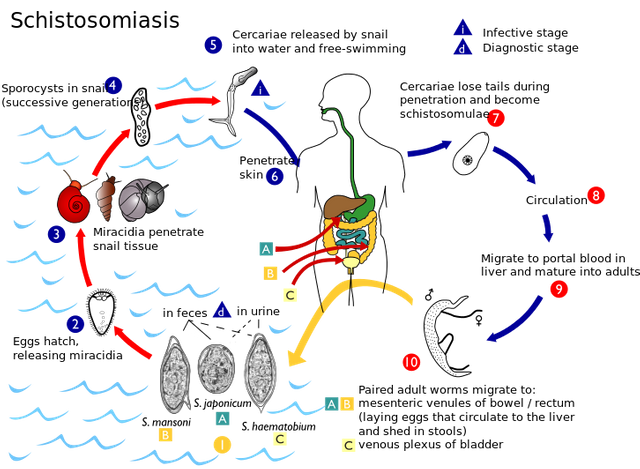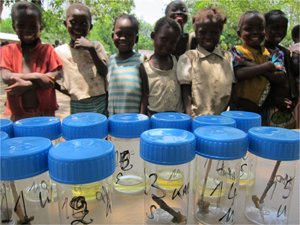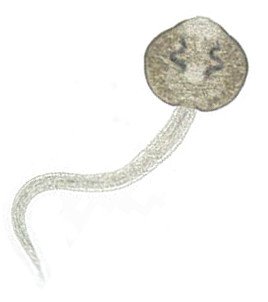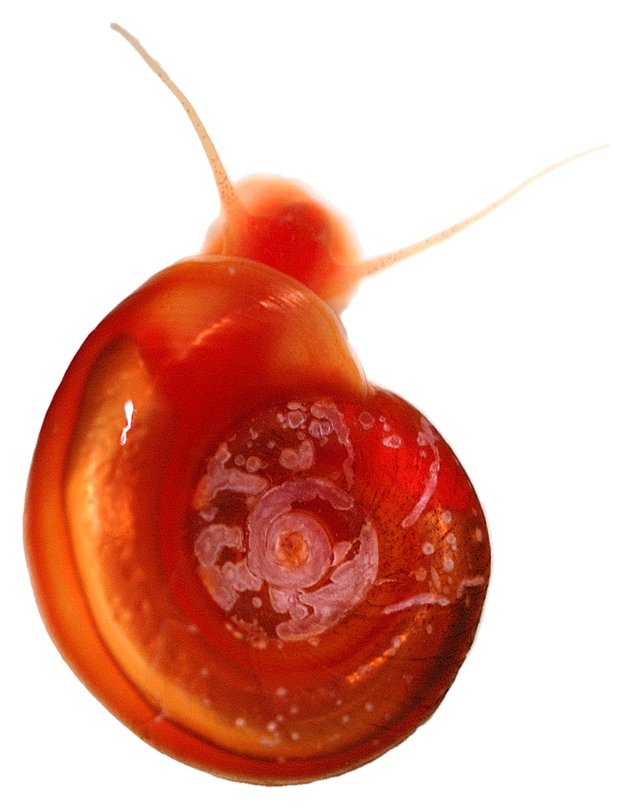Schistosomiasis; An Overview of a Neglected Tropical Disease
Man got Infected
Being poor and broke at the same time is a condition Peter hates to find himself. Sometimes he would think of ending his own life but, every time he tried to do so, something will come up, and the intended act is postponed. “I need no one to tell me, I know it myself, that the gods hate me so much, they punish me with poverty on purpose and made sure I never get to escape from it” with these words in his mind, he left the venue of his last attempted suicide before this article was written.
He was about drowning himself at the middle of the Apama River near his village (a village in Tropical Africa), when some “stupid girls and boys” (his words when he told me this story) appeared from behind nearby trees coming towards the river probably on a mission to have a nice time in the river after some “foolish” games in the woods. Irritated and frustrated at the same time, he walked out of the river hissed at the teenagers that caused him another failed suicide attempt. Somehow he already knew that attempt would fail too.
However, little did he know that he had picked up a group of neighbours from the water.
These neighbours had prayed to God for a human to come around within forty-eight (48) hours of their stay in water, so they could spend the rest of their life in the new human host.They would not mind the pain, the distress they will bring upon their new landlord (Peter) while they try to adapt and survive in their new environment (which is inside of Peter now). They just shook off their individual tails and penetrated Peter’s skin.
Well, if you would question one of their representatives that “why you guys bringing harm to your human host?” I am quite sure it will defend its colleagues with these words “It was not our intension to cause him pain, he did that to himself… I mean, he could have just allowed us do our thing! And survive in him without his unforgiving wicked immune system coming to attack me, my cliques, and our metabolic products. We are innocent! He caused it all!”
Peter walked back home with some new unfriendly friends finding their way through to his veins while he worried about his acquired poverty.
These neighbours struggled hard navigating through several tissues and stages, and eventually settle in blood vessels (veins) of Peter. They spend several weeks at their new residence growing and maturing into the adult stage of their life cycle.
Permit me at this junction to go with more of biological terminologies.
Life Cyle of Schistosoma
Peter in this case represents a susceptible human host and his new neighbours from the river (a freshwater) are infective cercariae larva of Schistosoma spp (blood flukes).
Before I continue with Peter’s situation, permit me to explain how these cercariae got to be in the river at the first instance.

Schistosoma Life Cyclesource
[License: CCO]
The life cycle of a typical Schistosoma species, particularly S. mansoni, S. heamatobium, S. japonicum, S. mekongi and S. intercalatum, begins from when their eggs are released together with urine or feaces of an infected individual especially when they are released directly into a freshwater (as the case is in rural areas of developing and underdeveloped countries where indiscriminate defecation is more pronounced). Depending on temperature, light and other factors such as how well the faeces dilute in the receiving water body, the eggs hatch into miracidia (a free-swimming ciliated larvae)source. Each miracidium moves through the water in search for a suitable and susceptible intermediate host.
The intermediate host is a freshwater snail of the genus Biomphalaria.
The choice of which of the many species of Biomphalaria would serve as a good intermediate host depends on the Schistosoma species involved and it is also region specific. In Africa, the intermediate hosts maybe any of B. glabratra, B. pfeifferi, B. choanomphala and B. sudanica. However, the more generally pronounced is B. glabratra.Schistosoma mansoni (a representative of the genus Schistosoma) penetrates soft tissues of B. glabratra. In the snail, miracidium the larvae trematode, undergo two generational development to a final infective stage ready for human host.
At first, they shed off their cilia, continue to grow, and eventually develop into mature sporocysts (mother schistosome). Next is multiple fission of mother sporocysts by a process called schizogony (an asexual form of reproduction where the nucleus first splits into several nuclei and the remaining protoplasm splits into same number of nuclei forming numerous daughter sporocysts source.
These young spoocysts then migrate to the liver and gonads where they develop fully into cercariae within the space of two to four weeks. Cercariae are sensitive to light, they therefore undergo positive phototropism (move towards the source of light). In doing so, they move out of the snail into the surrounding freshwater where they seek a definitive host (primarily humans). As mentioned earlier, they can only stay up to forty-eight (48) hours without a definitive host.
Now, we have seen how infective cercariae came into existence in Apama River. Let us then get back to what happened to Peter. We will talk about what happened in the veins around his visceral organs (internal organs especially the gut). This is because as mentioned earlier, cercariae tend to make themselves comfortable in those blood vessels.
After a successful penetration into Peter’s epidermal skin layer, the cercariae developed into another larva form called a schistosomule (an endoparasitic larva) which spent two or more days relaxing in his epidermis.
Schistosomules then enter into circulation beginning from dermal lymphatics and venules, to the lungs from where they continue journeying towards the hepatoportal circulation taking the road left side of the heart. At this particular junction in their journey (hepatoportal circulation), there is high probability of meeting an opposite sex.
If fortunate enough, they meet the love of their life respectively (opposite sex). Together the lovers develop into sexually mature adults and retire in mesenteric veins of Peter’s intestinal region, where the females yield eggs in hundreds that are deposited on the endothelial lining of the venous capillary walls. These eggs begin their journey out of Peter by migrating towards his intestinal lumen, from where they are released with faeces. In some cases with other species (for example, S. haematobium), the eggs move towards the bladder and uterus and are therefore expelled together with urine.
Brief Pathogenesis of Schistosomiasis
The initial presence of schistosome eggs in the intestine triggers allergic reactions which results into some deviation from general well-being of the body. The deviations are “serum sickness due to overwhelming immune complex formation” source. Also, not the entire population of eggs will mix with urine or stool to be released out of the body, “many are swept away in the circulation and become trapped in organs where they elicit strong granulomatous responses” source. In one sentence, “symptoms of schistosomiasis are caused by the body’s reaction to the worms' eggs” source.
Some Signs and Symptoms of Schistosomiasis
While all these processes of migration and development were going on inside of Peter, he was not spared of the results. At first, he began to feel feverish, then he employed the use of some local herbal drink that was meant to take away fever. Two days after, the fever has not alleviated, rather cough, chills, abdominal pain and muscle aches followed suit.
This went on for about two weeks, and he kept on seeking traditional way of treating himself of typhoid and malaria (self-diagnosis) which of course yielded no positive result. At a point he began to observe blood in his stool. He explained his situation to a friend of his that came to pay him a visit from the city. Paul, his friend, then advise that he come over to the city for a medical check-up at the city’s health centre, which he did.
Schistosomiasis Diagnosis and Treatment
After listening to his complaints, the physician (Dr. Sean) at the St. Mary’s Health Centre asked him what he did for a living. When he gave his answer, Sean was convinced that Peter was suffering from the disease shistosomiasis also known as bilharzia or snail fever. However, for proper diagnosis, Sean had Peter’s stool checked for presence of Schistosome eggs. Eggs of S. mansoni were identified in his stool, and this confirmed that Sean’s suspicion of schistosomiasis infection was right.
Yeah! You guessed right. The next step therefore was treatment. Peter was treated of the disease with the administration of praziquantel (40 mg/kg per day orally in two divided doses for one day) source.
After about two months, a follow up examination was carried out as advised by the CDC (Centres for Disease Control and Prevention) to confirm if initial cure was successful.
Prevention and Control Measures
Seeing that Peter got the infection from the very river that residents in his village get water needed domestically and for other uses. Sean, the physician taught it is only right that he and some of his colleagues go over to the village to enlighten them on preventive actions, treat other infected villagers and engage the Local Government Authorities (L.G.A) of the area on control measures targeted at cleaning up the contaminated river.
Extracts from the preventive measures class taking by Sean and his colleagues (I am quite sure they got these points from here):
- Since the river is the village’s major source of water for domestic use, it is advisable the people bring water obtained from it (the river) to boil for like a minute before usage.
- The villagers should as much as possible avoid swimming in this river.
- Already infected individuals must get themselves treated, at least to minimize the amount of schistosome eggs that gets into the river.
The class was followed by praziquantel administration to everyone tested positive to schistosomiasis diagnosis.

[Photo Credit: Sonia Pelletreau for CDC]
[License: CCO]
As at the time this article was written, the L.G.A was yet to respond to the anti-schistosomal Save Our Souls cry sent by Dr. Sean. However, whatever positive response that will come from their end will be targeted at bringing the disease incidence to the barest minimum and making the river area free of snails which are an important intermediate host in the life cycle of Schistosomes.
Some quick knowledge about schistosomiasis:
- An estimated 4,400 to 200,000 people die from schistosomiasis each year source.
- The disease is most commonly found in Africa, as well as Asia and South America source.
- Around 700 million people, in more than 70 countries, live in areas where the disease is common source.
- In tropical countries, schistosomiasis is second only to malaria among parasitic diseases with the greatest economic impact source.
- Schistosomiasis is listed as a neglected tropical disease source.
These diseases were neglected because they affect mostly the poorest in a typical developed or developing country, particularly those that have limited or no access to good amenities like housing and cannot get potable waters for themselves. In developed world, issues of NTDs were always swept under carpets by health issues involving major township and cities. In developing world however, the case is such because of the high cost of keeping up with preventive measures source.
CONCLUSION
In summary, people living in tropical regions or visitors in these areas can become infected by contact with freshwaters contaminated with schsitosome eggs which were formerly released with faeces or urine from infected individuals. The eggs develop into first larva (miracidium), which penetrate snail their intermediate host and undergo series of development (involving asexual and sexual reproduction) into the second larva stage (cercariae) which goes out of the snail to infect human host. We have discussed the possible symptoms, the diagnosis, treatment, prevention and control of the disease. We also highlighted some facts about the disease and a brief touch of neglected tropical diseases.
Thanks for reading!!!REFERENCES
- Neglected Tropical Diseases
- Schistosomal Life Cycle
- Prevention and Control of Schistosomiasis
- General Knowledge on Schistosomiasis
You are a Nigerian, and you write STEM related posts, you can use the #stemng tag also.



Sorry, I'm late to class....as usual. 😁
It a very lovely and insightful read, asides the fact that you had to use my name, Peter! 😈
Schistosomiaisis is possibly an underrated tropical disease, evident by the fact that even the drug of choice, praziquantel, is something you hardly find in hospitals or community pharmacist. It's often also misdiagnosed, and victims are placed on repeated doses of antibiotics for typhoid fever.
A saving grace, however, is that the artemisinins are also very effective against this flukes. So while treating malaria, you may subconsciously be treating schistosomiasis. So much for the holidays @greenrun is thankful for.
@gentencored in short, you are too much, chop kiss
Those days the drugs of choice is chloroquine. I dunno if it contains the artemisinins. I guess it was days of monotherapy ☺️
Thank God those days are long gone. I couldn't tolerate that drug. Chloroquine is a different molecule than the artemisinins. Artesunate (found in Combisunate), artemether (in Lumartem) and dihydroartemisinin (in waipa) belong to the artemisinin family.
Fortunately for me, I was not prone to the chloroquine's itchiness.
Lol....you be baba na.
Parasites like this give me the creeps. At least there is a readily available treatment.
Haha... Don't worry you are safe for now...lol
Thanks for your comment @tking77798
Nice one, very educative, writing it as a sort of story of one Mr peter made it more fun to read
Schistosomiasis is one very deadly water based disease and people need to be educated more about diseases like this, while the government can do more in providing safe water for the people which would eliminate the need to take water directly from surface water sources which are always very polluted
Nice work.
Thanks for stopping by @thurllanie
Yes, the Government and members of affected communities and areas prone to schistosomiasis outbreak all have roles to play in preventing this NTD.
Great dig up
I love the way the information is passed across....
Kudos
As an undergraduate, i am always marvelled at the extend to which our neigbour department (Parasitology) used to butres on schistomiasis. I can now feel their concern
No wonder. .. oh my dear country😁😂
Seriously??? Are u sure boiling for that time frame is enough to eliminate the eggs?? At what quantity per minute?
Oh thanks big time for stopping by! @teemike
Yes, according to CDC prevention guidelines, boiling water for one minute is enough to make the drawn water free of schistosome eggs.
Quantity per minute? Do you mean volume of water to be boiled per minute? If yes, I think that will depend on the capacity of the container to be used for the boiling process and/or quantity of water needed at that particular time.
I hope I answered your questions correctly?
Thanks once again!
Yes, you did. Actually, irrespective of the volume, water will boil at 100 degrees celsius. Even at 70 degrees, a lot of life forms have started dying. Water at 100 its considered pure. Leaving for an extra one minute, you're sure even molecules from Apama river gods are no more in the water. 😄
Haha...thank you for supporting with more sterilization by boiling terms...
Haha... What about eggs from the river goddess, will they die too??? Lol
lol....they should also... But you may want to know that some fortified ones called thermophiles can survive though. I don't think we have them around us.
Yeah! thanks for this too @getencored
I did have my fair share of swimming in open waters lots of time, thankfully the trematodes that cause schistosomiasis may be on holidays.
When I read this:
I thought Peter was hallucinating :)
Good article and thank you for sharing.
First, I really appreciate you commenting on this post... It is really an honour to have you here @greenrun
Lol, they were sure on holiday or the majority of the cercariae had spent more than 48 hours in the water. Oh, don't mind Mr Peter he never wanted to die for real... Must he wait till those guys come around? Always looking for an excuse...hahaThank you.
The most dangerous aspect of this trematodes is the action of the cercaria which has the ability to penetrate the body.
Little creatures with powerful potentials.
Masterfully crafted piece u got here
Congratulations @herbayomi! You have completed the following achievement on Steemit and have been rewarded with new badge(s) :
Click on the badge to view your Board of Honor.
If you no longer want to receive notifications, reply to this comment with the word
STOPCongratulations @herbayomi! You have completed the following achievement on Steemit and have been rewarded with new badge(s) :
Click on the badge to view your Board of Honor.
If you no longer want to receive notifications, reply to this comment with the word
STOPDo not miss the last post from @steemitboard:
SteemitBoard World Cup Contest - The results, the winners and the prizes
Hi @herbayomi!
Your post was upvoted by utopian.io in cooperation with steemstem - supporting knowledge, innovation and technological advancement on the Steem Blockchain.
Contribute to Open Source with utopian.io
Learn how to contribute on our website and join the new open source economy.
Want to chat? Join the Utopian Community on Discord https://discord.gg/h52nFrV
So bad it's killing much people and yet it is being neglected. Proper eduction can help prevent this disease among so many persons. It's a nice read.
Yes, you are right @mr-aaron
It was nice having you here, thanks for stopping by.